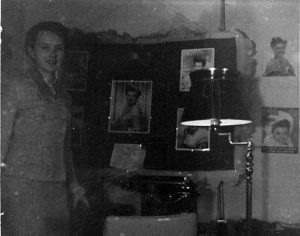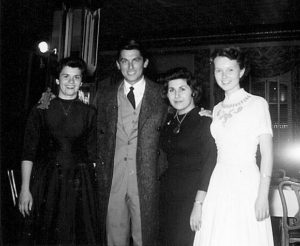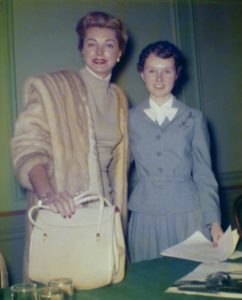Author as Adolescent

By Dorothy Rice Bennett
A youthful would-be writer is filled with great dreams and ambitions—like writing the great American novel, selling a screenplay, being published and making a fortune. Yet, as we all learn eventually, our teenage view of ourselves and the world can be wacky, off center, and incredibly naïve. I know my adolescence was all of the above.
Speedway, Indiana, could be exciting every May when the Indy 500 mayhem came to town. But the rest of the year Speedway was just a small town. My world comprised two blocks by two blocks. Everything of any importance in my daily life was within walking distance of my house, from school, to church, to the grocery, the drugstore, the bank, and the movie theater.
Let’s pause at the movie theater around the corner. It’s where I hung out, because my parents were both employed full time and running their own business. I was an only child. With no one at home to talk with, I went to the movies. Of course, when you go to the movies a lot, you tend to become involved with movies and movie stars. One thing leads to another.
Esther’s biggest fan
Just before I turned eleven, in February of 1953, I saw a movie at that theater that was going to change my life: Million Dollar Mermaid starring Esther Williams. I loved the film and skipped and sang the movie’s theme song, “Let Me Call You Sweetheart,” all the way home. It was a musical biopic about Australian Annette Kellerman, who like Esther Williams, swam her way to stardom in motion pictures in the early twentieth century. It was a real American tale in which childhood polio and poverty were overcome as Annette achieved success as a swimmer. Perfect story for a child who needed a heroine, a child who wanted a bigger world than the one in which she lived.
Now I hung around the corner drug store reading movie magazines, buying ones that had articles about Esther, joining an Esther Williams Fan Club in Florida, then deciding that if a man in Florida could have a fan club for Esther Williams, why couldn’t I? So I asked, and on June 4, 1955, I received a letter from Esther allowing me to become president of the International Esther Williams Fan Club. Now I could write something besides short stories for my classmates. I could create fan club journals for my members and mail them to far away places, like England, Australia, and Trinidad in the Caribbean.
 So I did. I bought a used AB Dick mimeograph and learned to type (thirty words a minute with one finger and a thumb), made stencils, and published in my basement “office” my own fan club journals, thirty pages long with pictures of Esther and my various guest stars, including Mitzi Gaynor, whom I later had the chance to meet. I then assembled and mailed the journals to my 150 members. It was a fun hobby, and I gradually learned that many adults did the same thing—some of them weren’t so happy when at fifteen I accepted an award for most active fan club of 1957 in New York City, from a fan club organization. At the awards dinner, I met actor Robert Evans and Hollywood columnist Rona Barrett, both early in their respective careers, and also one of my club members, Nancy Schiffmacher, from East
So I did. I bought a used AB Dick mimeograph and learned to type (thirty words a minute with one finger and a thumb), made stencils, and published in my basement “office” my own fan club journals, thirty pages long with pictures of Esther and my various guest stars, including Mitzi Gaynor, whom I later had the chance to meet. I then assembled and mailed the journals to my 150 members. It was a fun hobby, and I gradually learned that many adults did the same thing—some of them weren’t so happy when at fifteen I accepted an award for most active fan club of 1957 in New York City, from a fan club organization. At the awards dinner, I met actor Robert Evans and Hollywood columnist Rona Barrett, both early in their respective careers, and also one of my club members, Nancy Schiffmacher, from East Hempstead, Long Island, New York.
Hempstead, Long Island, New York.
Going to college?
Having a fan club and hanging around a movie theater ultimately brought new opportunities into my world. The theatre owner met me, wrote to Hollywood on my behalf, arranged an Esther Williams double feature at our neighborhood theater, which was filled to capacity that night, and she introduced me to the crowd and gave me a personally autographed photo from Esther herself. The owner, Eva Mae Sconce, also decided, after she knew me a while, that I needed a change; she encouraged me to apply to college, under a program featured in Reader’s Digest about several US colleges that accepted high school sophomores and juniors as early admission students. Mrs. Sconce thought I belonged somewhere else other than Speedway.
While awaiting this college dream to be fulfilled (in 1959 when I was seventeen), I took high school journalism classes and worked as a part time stringer for The Indianapolis News by sending in stories about school events (and being paid by the column inch). I used my mimeograph machine not only for two fan clubs I ran (Esther’s and a one for a young actor, John Wilder), but also placed an ad in the local newspaper and received several small printing jobs from Speedway citizens. (My first entrepreneurial adventure—beyond parking cars for the Indy races). To design covers and provide artwork, I needed a light box, but I didn’t have the money to buy one. I took a cardboard box, a piece of glass, a light bulb socket, light bulb, and an extension cord, and made my own light box for just pennies. And it worked perfectly well for my projects.
Mrs. Sconce encouraged my writing. She suggested I write a book about my involvement with Esther Williams, whom I finally met in April of 1958, when the MGM star visited Indianapolis for the annual home show and dedicated a new swimming pool  from her pool company in New York. I was allowed to spend two days touring Indianapolis with Esther and learned a lot about her. Of course, being fifteen, I couldn’t believe my good fortune. Among the activities that happened during those two days was an interview with Esther for high school journalists that I hosted in a downtown hotel. Some nice stories in local school papers came out of that interview. Despite the fun and excitement, I felt I didn’t know enough, or have the perspective, to write an adult piece about my relationship with Esther. I turned out a few pages and quit. Not me, not yet, anyway.
from her pool company in New York. I was allowed to spend two days touring Indianapolis with Esther and learned a lot about her. Of course, being fifteen, I couldn’t believe my good fortune. Among the activities that happened during those two days was an interview with Esther for high school journalists that I hosted in a downtown hotel. Some nice stories in local school papers came out of that interview. Despite the fun and excitement, I felt I didn’t know enough, or have the perspective, to write an adult piece about my relationship with Esther. I turned out a few pages and quit. Not me, not yet, anyway.
First novella
I also wrote my first novel (a novella, actually), Anna Be Accepted. Not much more than fifty pages long, it was the story of an impoverished teenage girl who meets a nice boy from the better side of town—and from a family that wants nothing to do with her until she saves the youngest son from drowning. It was a simple and positive story about being good, doing your best, forgiving people who are not nice to you, and ultimately coming out a winner. I printed the story on my mimeograph, assembled it, and sold copies to friends and family for fifty cents.
As an avid reader—at times during my childhood I read seven books a week—I knew that I was young and very naïve. I could tell stories and put words together, but I sensed that there was so much I didn’t know—I realized there was little depth to my writing. So when I was encouraged to write, I loved the idea of being an author, and I tried to put ideas down on paper, but soon I filed my dreams away for the future somewhere. Someday, after college and when I had really lived and had something meaningful to say.

Comments
Author as Adolescent — No Comments
HTML tags allowed in your comment: <a href="" title=""> <abbr title=""> <acronym title=""> <b> <blockquote cite=""> <cite> <code> <del datetime=""> <em> <i> <q cite=""> <s> <strike> <strong>